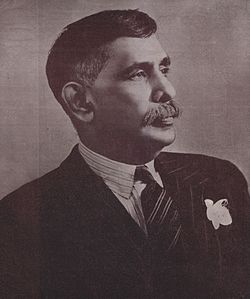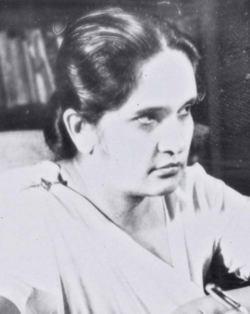List of prime ministers of Sri Lanka
 From Wikipedia - Reading time: 19 min
From Wikipedia - Reading time: 19 min
- Top left: D. S. Senanayake became the first Prime Minister of Ceylon in 1947.
- Top right: Sirimavo Bandaranaike was the first female Prime Minister of Ceylon and its longest-serving prime minister, holding office for over 17 years across three separate terms.
- Bottom left: Ranasinghe Premadasa was the longest-serving prime minister without interruption, holding office for over 10 years from 1978 to 1989.
- Bottom right: Ranil Wickremesinghe has served as prime minister on four separate occasions and has been sworn in six times, the most of any Sri Lankan prime minister.
| This article is part of a series on the |
| Politics of Sri Lanka |
|---|
 |
There have been sixteen prime ministers of Sri Lanka since the creation of the position in 1947, prior to the independence of the country (then known as Ceylon). The prime minister of Ceylon was the head of the government until 1972. In 1972, the country was renamed as the Free, Sovereign and Independent Republic of Sri Lanka, and the position was known as the prime minister of Sri Lanka from then onwards. The prime minister also held the unified Ministry of External Affairs and Defence until 1977, when the government of J. R. Jayewardene split the ministry into two ministries, forming the Ministry of Defence and the Ministry of Foreign Affairs.
In 1978, after Jayewardene became the president, new constitutional changes were introduced. The position of the executive president was introduced, resulting in the powers of the prime minister being reduced. The president became the head of state and chief executive,[1] and the prime minister became a weak head of government.[2]
Under the current constitution of Sri Lanka, the prime minister is the leader of the Cabinet business and also functions as a deputy to the president. In the event a president dies in office, the prime minister becomes the acting president until the Parliament convenes to elect a successor or new elections can be held to elect a new president. Such was the case in 1993, when President Ranasinghe Premadasa was assassinated and Prime Minister Dingiri Banda Wijetunga took office as president.[3]
On 28 April 2015, the Parliament approved the 19th Amendment to the Constitution of Sri Lanka which gives the power of the government to the prime minister, while the president remains the head of state, head of the Cabinet, and commander-in-chief.[4]
Of the sixteen prime ministers who have held the office since the introduction of the position in 1947, one has held the office four times, two have held office thrice, and two have held office twice. Six prime ministers have gone on to become president of the country.[5]
Ranil Wickremesinghe has been sworn in as prime minister the most times in the country's history, on six occasions (May 1993, December 2001, January 2015, August 2015, December 2018 and May 2022),[6][7] whilst Dudley Senanayake and Sirimavo Bandaranayake have each been appointed three times. Mahinda Rajapaksa is the only prime minister who was suspended from his duties by the Supreme Court,[8][9][10] becoming the first and only de facto prime minister of Sri Lanka in 2018.
List of prime ministers
[edit]- Parties
United National Party (7) Sri Lanka Freedom Party (6) Sinhala Bhasha Peramuna (1) Sri Lanka Podujana Peramuna (2) National People's Power (1)
| No. | Portrait | Name (Birth–Death) Constituency |
Term of office Electoral mandates Time in office |
Other ministerial offices held while Prime Minister |
Political party of PM (Alliance) |
Government | Refs | |||
|---|---|---|---|---|---|---|---|---|---|---|
| 1 | 
|
D. S. Senanayake දොන් ස්ටීවන් සේනානායක டான் ஸ்டீபன் சேனாநாயக்க (1883–1952) Mirigama |
24 September 1947 |
22 March 1952† |
Minister of External Affairs and Defence | United National Party | D. S. Senanayake | 1st | [11] | |
| 1947 | ||||||||||
| 4 years, 5 months and 27 days | ||||||||||
| The first Prime Minister of Ceylon. The country gained independence from the United Kingdom during his term of office. Died in office.[12] | ||||||||||
| 2 | 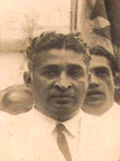
|
Dudley Senanayake ඩඩ්ලි ෂෙල්ටන් සෙනානායක டட்லி சேனநாயக்கா (1911–1973) Dedigama |
26 March 1952 |
12 October 1953 |
Minister of External Affairs and Defence Minister of Agriculture & Lands & Minister of Health & Local Government |
United National Party | Dudley Senanayake I | 1st 2nd |
[11] | |
| 1952 | ||||||||||
| 1 year, 6 months and 16 days | ||||||||||
| Appointed as Prime Minister following the death of his father, D. S. Senanayake. His party won at the general elections held in 1952, and he continued to hold office without re-appointment. Resigned amidst the 1953 Ceylonese Hartal.[13] | ||||||||||
| 3 | 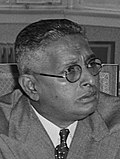
|
Sir John Kotelawala ශ්රිමත් ජෝන් කොතලාවල சேர் ஜோன் கொத்தலாவலை CH, KBE, KStJ, CLI (1897–1980) Dodangaslanda |
12 October 1953 |
12 April 1956 |
Minister of External Affairs and Defence & Minister of Transport & Works |
United National Party | Kotelawala | 2nd | [11] | |
| — | ||||||||||
| 2 years and 6 months | ||||||||||
| Sri Lanka joined the United Nations during Kotelawala's term of office.[14] | ||||||||||
| 4 | 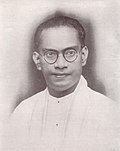
|
S. W. R. D. Bandaranaike සොලමන් වෙස්ට් රිජ්වේ ඩයස් බණ්ඩාරනායක சாலமன் வெஸ்ட் ரிட்ஜ்வே டயஸ் பண்டாரநாயக்கா (1899–1959) Attanagalla |
12 April 1956 |
26 September 1959† |
Minister of External Affairs and Defence | Sri Lanka Freedom Party (MEP) |
S. W. R. D. Bandaranaike | 3rd | [11] | |
| 1956 | ||||||||||
| 3 years, 5 months and 14 days | ||||||||||
| Bandaranaike changed the official language of the country from English to Sinhalese. He was assassinated during his term of office.[15] | ||||||||||
| 5 | 
|
Wijeyananda Dahanayake විජයානන්ද දහනායක விஜயானந்த தகநாயக்கா (1902–1997) Galle |
26 September 1959 |
20 March 1960 |
Minister of External Affairs and Defence | Sinhala Bhasha Peramuna (MEP) |
Dahanayake | 3rd | [11] | |
| — | ||||||||||
| 5 months and 23 days | ||||||||||
| Appointed following the assassination of Bandaranaike. Following disagreements with the members of his government and party, he was forced to dissolve the parliament.[16] | ||||||||||
| (2) | 
|
Dudley Senanayake ඩඩ්ලි සේනානායක டட்லி சேனநாயக்கா (1911–1973) Dedigama |
21 March 1960 |
21 July 1960 |
Minister of External Affairs and Defence | United National Party | Dudley Senanayake II | 4th | [11] | |
| March 1960 | ||||||||||
| 4 months | ||||||||||
| Senanayake's government was defeated within a month. Senanayake continued to serve as prime minister until 21 July 1960. | ||||||||||
| 6 | 
|
Sirimavo Bandaranaike සිරිමාවො රත්වත්තේ ඩයස් බණ්ඩාරනායක சிறிமா ரத்வத்தே டயஸ் பண்டாரநாயக்கே (1916–2000) |
21 July 1960 |
25 March 1965 |
Minister of External Affairs and Defence | Sri Lanka Freedom Party | Sirimavo Bandaranaike I | 5th | [11] | |
| July 1960 | ||||||||||
| 4 years, 8 months and 4 days | ||||||||||
| Sirimavo Bandaranaike was the world's first female prime minister.[17] She was not a member of Parliament at the time of her appointment, and was appointed to the Senate on 2 August 1960. | ||||||||||
| (2) | 
|
Dudley Senanayake ඩඩ්ලි සේනානායක டட்லி சேனநாயக்கா (1911–1973) Dedigama |
25 March 1965 |
29 May 1970 |
Minister of External Affairs and Defence | United National Party | Dudley Senanayake III | 6th | [11] | |
| 1965 | ||||||||||
| 5 years, 2 months and 4 days | ||||||||||
| Senanayake was elected prime minister for the third time, when his party formed a coalition government with the help of six other parties, after an election which did not give a clear majority to any party. The agriculture sector was given high priority during his term of office.[18] | ||||||||||
| (6) | 
|
Sirimavo Bandaranaike සිරිමාවො රත්වත්තේ ඩයස් බණ්ඩාරනායක சிறிமா ரத்வத்தே டயஸ் பண்டாரநாயக்கே (1916–2000) Attanagalla |
29 May 1970 |
23 July 1977 |
Minister of External Affairs and Defence & Minister of Planning & Employment |
Sri Lanka Freedom Party | Sirimavo Bandaranaike II | 7th | [11] | |
| 1970 | ||||||||||
| 7 years, 1 month and 24 days | ||||||||||
| Sirimavo Bandaranaike declared the country a republic, and changed the name of the country from Ceylon to Sri Lanka.[17] Nationalized many companies in the plantation sector and imposed restrictions on several imports. This led to the downfall of the country's economy and her defeat in the 1977 general elections.[17] | ||||||||||
| 7 | 
|
Junius Richard Jayewardene ජුනියස් රිචඩ් ජයවර්ධන ஜூனியஸ் ரிச்சட் ஜயவர்தனா (1906–1996) Colombo West |
23 July 1977 |
4 February 1978 |
Minister of Defence Minister of Planning & Economic Affairs & Minister of Plan Implementation |
United National Party | Jayewardene | 8th | [11] | |
| 1977 | ||||||||||
| 6 months and 12 days | ||||||||||
| Introduced the executive presidency in 1978 and became president.[19] | ||||||||||
| 8 | 
|
Ranasinghe Premadasa රණසිංහ ප්රේමදාස ரணசிங்க பிரேமதாசா (1924–1993) Colombo Central |
6 February 1978 |
2 January 1989 |
Minister of Local Government, Housing & Construction | United National Party | Jayewardene | 8th | [11] | |
| — | ||||||||||
| 10 years, 10 months and 27 days | ||||||||||
| The first prime minister to be appointed after the constitutional changes of 1978, with the powers of the position reduced significantly.[20] | ||||||||||
| 9 | Dingiri Banda Wijetunga ඩිංගිරි බණ්ඩා විජේතුංග டிங்கிரி பண்ட விஜேதுங்க (1916–2008) Yatinuwara |
6 March 1989 |
7 May 1993 |
Minister of Finance & Minister of Labour & Vocational Training |
United National Party | Premadasa | 9th | [11] | ||
| 1989 | ||||||||||
| 4 years, 2 months and 1 day | ||||||||||
| Appointed in a surprise move by President Ranasinghe Premadasa. Wijetunga himself reacted in surprise at the appointment.[3] He resigned from the post on 28 March 1990 but was reappointed two days later on 30 March 1990. Ascended to the presidency following Premadasa's assassination. | ||||||||||
| 10 | 
|
Ranil Wickremesinghe රනිල් වික්රමසිංහ ரணில் விக்ரமசிங்க (born 1949) Biyagama |
7 May 1993 |
19 August 1994 |
United National Party | Wijetunga | 9th | [11] | ||
| — | ||||||||||
| 1 year, 3 months and 12 days | ||||||||||
| Appointed as prime minister following the assassination of former president Ranasinghe Premadasa and Wijetunga's ascension to the presidency.[21] | ||||||||||
| 11 | 
|
Chandrika Kumaratunga චන්ද්රිකා බණ්ඩාරනායක කුමාරතුංග சந்திரிகா பண்டாரநாயக்கே குமாரதுங்கா (born 1945) Attanagalla |
19 August 1994 |
12 November 1994 |
Sri Lanka Freedom Party (PA) |
Wijetunga | 10th | [11] | ||
| 1994 | ||||||||||
| 2 months and 24 days | ||||||||||
| Served as the prime minister for a short period, before contesting in the 1994 presidential elections and being elected as president.[22] | ||||||||||
| (6) | 
|
Sirimavo Bandaranaike සිරිමාවො රත්වත්තේ ඩයස් බණ්ඩාරනායක சிறிமா ரத்வத்தே டயஸ் பண்டாரநாயக்கே (1916–2000) National List |
14 November 1994 |
9 August 2000 |
Sri Lanka Freedom Party (PA) |
Kumaratunga | 10th | [11] | ||
| — | ||||||||||
| 5 years, 8 months and 26 days | ||||||||||
| Sirimavo Bandaranaike was appointed as the prime minister for a third and final term when her daughter Chandrika Kumaratunga was appointed as the president of Sri Lanka. Resigned in 2000.[17] | ||||||||||
| 12 | 
|
Ratnasiri Wickremanayake රත්නසිරි වික්රමනායක ரத்னசிறி விக்கிரமநாயக்க (1933–2016) Horana |
10 August 2000 |
7 December 2001 |
Sri Lanka Freedom Party (PA) |
Kumaratunga | 10th 11th |
[11] | ||
| 2000 | ||||||||||
| 1 year, 3 months and 27 days | ||||||||||
| Wickremanayake assumed the office of prime minister following the resignation of Sirimavo Bandaranaike.[2] | ||||||||||
| (10) | 
|
Ranil Wickremesinghe රනිල් වික්රමසිංහ ரணில் விக்ரமசிங்க (born 1949) Colombo |
9 December 2001 |
6 April 2004 |
United National Party (UNF) |
Kumaratunga | 12th | [11] | ||
| 2001 | ||||||||||
| 2 years, 3 months and 28 days | ||||||||||
| Wickremesinghe's term of office ended early when President Chandrika Kumaratunga dismissed his government and called for a general election in 2004.[23] | ||||||||||
| 13 | 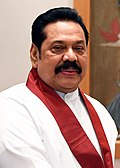
|
Mahinda Rajapaksa මහින්ද රාජපක්ෂ மஹிந்த ராஜபக்ஷ (born 1945) Hambantota |
6 April 2004 |
19 November 2005 |
Ministry of Highways | Sri Lanka Freedom Party (UPFA) |
Kumaratunga | 13th | [11] | |
| 2004 | ||||||||||
| 1 year, 7 months and 13 days | ||||||||||
| Appointed as prime minister of the cabinet that was formed after the elections following the dismissal of Wickremesinghe's government by President Chandrika Kumaratunga. He won the presidential elections in 2005 and was appointed President of Sri Lanka.[24] | ||||||||||
| (12) | 
|
Ratnasiri Wickremanayake රත්නසිරි වික්රමනායක ரத்னசிறி விக்கிரமநாயக்க (1933–2016) National List |
19 November 2005 |
21 April 2010 |
Sri Lanka Freedom Party (UPFA) |
Mahinda Rajapaksa | 13th | [11] | ||
| — | ||||||||||
| 4 years, 5 months and 2 days | ||||||||||
| Appointed as prime minister when Rajapaksa assumed the presidency.[2] | ||||||||||
| 14 | 
|
D. M. Jayaratne දිසානායක මුදියන්සේලාගේ ජයරත්න திசாநாயக்க முதியன்சேலாகே ஜயரத்ன (1931–2019) National List |
21 April 2010 |
9 January 2015 |
Minister of Buddhasasana & Religious Affairs | Sri Lanka Freedom Party (UPFA) |
Mahinda Rajapaksa | 14th | [11] | |
| 2010 | ||||||||||
| 4 years, 8 months and 19 days | ||||||||||
| Appointed as prime minister after the incumbent Sri Lanka Freedom Party won the parliamentary elections held in April 2010. | ||||||||||
| (10) | 
|
Ranil Wickremesinghe රනිල් වික්රමසිංහ ரணில் விக்ரமசிங்க (born 1949) Colombo |
9 January 2015 |
26 October 2018 |
Minister of National Policies and Economic Affairs | United National Party (UNFGG) |
Sirisena I | 14th | [11] | |
| 2015 | Sirisena II | 15th | ||||||||
| 3 years, 9 months and 17 days | ||||||||||
| Appointed as prime minister by President Maithripala Sirisena after his victory in the 2015 presidential elections and was re-elected in the 2015 parliamentary elections. | ||||||||||
| (13) | 
|
Mahinda Rajapaksa මහින්ද රාජපක්ෂ மஹிந்த ராஜபக்ஷ (born 1945) Kurunegala (de facto) |
26 October 2018 |
15 December 2018 |
Minister of Finance and Economic Affairs | Sri Lanka Podujana Peramuna | Sirisena III | 15th | [11] | |
| — | ||||||||||
| 1 month and 19 days | ||||||||||
| 2018 Sri Lankan constitutional crisis: Appointed by Sirisena after the incumbent Wickremesinghe was suddenly dismissed by Sirisena. Rajapaksa's term was disputed by Wickremesinghe and Sri Lanka had two concurrent prime ministerial claimants. After failing to conduct a majority support vote in the house, Rajapaksa's duties were suspended by the Supreme Court of Sri Lanka.[25] Subsequently resigned from office to pave way for Wickremesinghe.[26] | ||||||||||
| (10) | 
|
Ranil Wickremesinghe රනිල් වික්රමසිංහ ரணில் விக்ரமசிங்க (born 1949) Colombo |
16 December 2018 |
21 November 2019 |
Minister of National Policies and Economic Affairs | United National Party (UNFGG) |
Sirisena IV | 15th | [11] | |
| — | ||||||||||
| 11 months and 5 days | ||||||||||
| Restored as prime minister after the 2018 Sri Lankan constitutional crisis. Resigned in 2019. | ||||||||||
| (13) | 
|
Mahinda Rajapaksa මහින්ද රාජපක්ෂ மஹிந்த ராஜபக்ஷ (born 1945) Kurunegala |
21 November 2019 |
9 May 2022 |
Minister of Finance Minister of Urban Development & Housing Minister of Buddhasasana, Religious & Cultural Affairs |
Sri Lanka Podujana Peramuna (SLFPA) |
Gotabaya Rajapaksa I | 15th | [11] | |
| 2020 | Gotabaya Rajapaksa II | 16th | ||||||||
| 2 years, 5 months and 18 days | Gotabaya Rajapaksa III | |||||||||
| Appointed by President Gotabaya Rajapaksa, following the resignation of Ranil Wickremesinghe after the 2019 presidential election and was re-elected in the 2020 parliamentary elections. Much of his tenure was plagued with major economic and political crises. Resigned amidst the 2022 Sri Lankan protests. | ||||||||||
| (10) | 
|
Ranil Wickremesinghe රනිල් වික්රමසිංහ ரணில் விக்ரமசிங்க (born 1949) National List |
12 May 2022 |
21 July 2022 |
Minister of Finance | United National Party | Gotabaya Rajapaksa IV | 16th | [11] | |
| — | ||||||||||
| 2 months and 9 days | ||||||||||
| Appointed by President Gotabaya Rajapaksa, following the resignation of Mahinda Rajapaksa amidst the 2022 Sri Lankan political crisis. On 13 July 2022, he became the acting president of the republic as Gotabaya Rajapaksa fled the country and resigned amidst the protests and was outright elected as president a week later. | ||||||||||
| 15 | 
|
Dinesh Gunawardena දිනේෂ් ගුණවර්ධන தினேஷ் குணவர்தன (born 1949) Colombo |
22 July 2022 |
23 September 2024 |
Minister of Public Administration, Home Affairs, Provincial Councils and Local Government | Sri Lanka Podujana Peramuna (SLFPA) |
Wickremesinghe | 16th | [11] | |
| — | ||||||||||
| 2 years, 2 months and 1 day | ||||||||||
| Appointed by President Ranil Wickremesinghe following his ascension to the presidency. Temporarily succeeded Mahinda Rajapaksa as the de facto leader of the ruling SLPP during the 2022 Sri Lankan political crisis.[27][28] | ||||||||||
| 16 | Harini Amarasuriya හරිනි අමරසූරිය ஹரிணி அமரசூரிய (born 1970) Colombo |
24 September 2024 |
Incumbent | Minister of Education, Higher Education and Vocational Education | National People's Power | Dissanayake I | 16th | [11] | ||
| 2024 | Dissanayake II | 17th | ||||||||
| 6 months and 14 days | ||||||||||
| Appointed by President Anura Kumara Dissanayake following the resignation of Dinesh Gunawardena after the 2024 presidential election and was re-elected in the 2024 parliamentary elections. | ||||||||||
List of prime ministers by length of term
[edit]| No. | Name | Party | No. of terms | Length of term | ||
|---|---|---|---|---|---|---|
| Longest continuous term | Total years of premiership | |||||
| 1 | Sirimavo Bandaranaike | SLFP | 3 | 7 years, 55 days | 17 years, 204 days | |
| 2 | Ranasinghe Premadasa | UNP | 1 | 10 years, 331 days | 10 years, 331 days | |
| 3 | Ranil Wickremesinghe | UNP | 5 | 3 years, 290 days | 8 years, 191 days | |
| 4 | Dudley Senanayake | UNP | 3 | 5 years, 65 days | 7 years, 20 days | |
| 5 | Ratnasiri Wickremanayake | SLFP | 2 | 4 years, 153 days | 5 years, 270 days | |
| 6 | D. M. Jayaratne | SLFP | 1 | 4 years, 263 days | 4 years, 263 days | |
| 7 | D. S. Senanayake | UNP | 1 | 4 years, 180 days | 4 years, 180 days | |
| 8 | Mahinda Rajapaksa | SLFP, SLPP | 3 | 2 years, 169 days | 4 years, 80 days | |
| 9 | Dingiri Banda Wijetunga | UNP | 1 | 4 years, 62 days | 4 years, 62 days | |
| 10 | S. W. R. D. Bandaranaike | SLFP | 1 | 3 years, 167 days | 3 years, 167 days | |
| 11 | Dinesh Gunawardena | SLPP | 1 | 2 years, 63 days | 2 years, 63 days | |
| 12 | John Kotelawala | UNP | 1 | 2 years, 183 days | 2 years, 183 days | |
| 13 | J. R. Jayewardene | UNP | 1 | 196 days | 196 days | |
| 14 | Harini Amarasuriya | NPP | 1 | 195 days* | 195 days* | |
| 15 | Wijeyananda Dahanayake | SBP | 1 | 176 days | 176 days | |
| 16 | Chandrika Kumaratunga | SLFP | 1 | 85 days | 85 days | |
Timeline
[edit]
Relations between prime ministers
[edit]Out of the 16 distinct people to have held the office of prime minister, 8 have come from three political families.
| Relations | Prime ministers | Political family |
|---|---|---|
| Husband and wife | S. W. R. D. Bandaranaike and Sirimavo Bandaranaike | Bandaranaike |
| Father and son | D. S. Senanayake and Dudley Senanayake | Senanayake |
| Father and daughter | S. W. R. D. Bandaranaike and Chandrika Kumaratunga | Bandaranaike |
| Mother and daughter | Sirimavo Bandaranaike and Chandrika Kumaratunga | Bandaranaike |
| Uncle and nephew | D. S. Senanayake and John Kotelawala | Senanayake |
| Cousins | Dudley Senanayake and John Kotelawala | Senanayake |
| First cousins once removed | Junius Richard Jayewardene and Ranil Wickremesinghe | Wijewardene |
Living prime ministers
[edit]| Prime Minister | Date of birth | Premiership |
|---|---|---|
| Ranil Wickremesinghe | 24 March 1949 | 1993–1994, 2001–2004, 2015–2018, 2018–2019, 2022 |
| Chandrika Kumaratunga | 29 June 1945 | 1994–1994 |
| Mahinda Rajapaksa | 18 November 1945 | 2004–2005, 2018, 2019–2022, |
| Dinesh Gunawardena | 2 March 1949 | 2022–2024 |
| Harini Amarasuriya | 6 March 1970 | 2024–present |
See also
[edit]- List of presidents of Sri Lanka
- Prime Minister's Office (Sri Lanka)
- Leader of the Opposition (Sri Lanka)
Notes
[edit]- The Parliament was known as the "House of Representatives" during the period of 1947–1972
- In 1972, the country was named "Free, Sovereign and Independent Republic of Sri Lanka", and the Parliament was named as the National State Assembly.
- Under the constitutional changes of 1978, the country was renamed as the "Democratic Socialist Republic of Sri Lanka", and the Parliament was referred to as "Parliament of the Democratic Socialist Republic of Sri Lanka".
References
[edit]- General
- "Former Prime Ministers" (.html). Official Website of the Government of Sri Lanka. Retrieved 2008-10-04.
- "Handbook of Parliament - Prime Ministers" (.jsp). The Parliament of Sri Lanka. Retrieved 2008-10-04.
- "PMs of Sri Lanka" (.htm). Prime Minister's Office. Retrieved 2008-10-05.
- Specific
- ^ V. Jayanth (2003-11-15). "Sri Lanka's executive presidency"[usurped]. The Hindu. Retrieved 2008-10-05.
- ^ a b c V.S. Sambandan (2005-11-22). "Ratnasiri Wickremanayake appointed Sri Lankan Premier" Archived 10 November 2012 at the Wayback Machine. The Hindu. Retrieved 2008-10-04.
- ^ a b M.B. Dassanayake (2008-09-22). "Dingiri Banda Wijetunga - the journey to greatness" Archived 27 September 2008 at the Wayback Machine. Daily News. Retrieved 2008-10-04.
- ^ "Sri Lanka: 19A to the Constitution passed in parliament".
- ^ Wanniarachchi, Lakruwan. "Sri Lanka's new president gets down to mending ties". 10 January 2015. Business Insider AFP. Archived from the original on 13 January 2015. Retrieved 10 January 2015.
- ^ "International News, Breaking World News, Latest International News". The Hindu. Archived from the original on 22 December 2016. Retrieved 26 December 2016.
- ^ Jayasinghe, Uditha; Pal, Alasdair (12 May 2022). "He's back: Wickremesinghe named Sri Lankan PM for 6th time amid crisis". Reuters.
- ^ "Sri Lankan court bars Rajapakse from working as PM". 4 December 2018. Archived from the original on 30 October 2019. Retrieved 30 October 2019.
- ^ "Sri Lanka temporarily bars Rajapaksa from acting as PM". Archived from the original on 30 October 2019. Retrieved 30 October 2019.
- ^ "Sri Lanka court denies Rajapakse authority to act as PM". Archived from the original on 30 October 2019. Retrieved 30 October 2019.
- ^ a b c d e f g h i j k l m n o p q r s t u v w x y z aa "Prime Ministers". Parliament.lk. Archived from the original on 30 August 2022. Retrieved 4 January 2014.
- ^ "Senanayake, Don Stephen (1884–1952)" Archived 27 May 2009 at the Wayback Machine. The History Channel. Retrieved 2008-10-04.
- ^ Buddhika Kurukularatne (2007-06-19). "Dudley – the reluctant Prince" Archived 3 March 2016 at the Wayback Machine. Daily Mirror. Retrieved 2008-10-04.
- ^ K. T. Rajasingham (2001-11-17). "Sri Lanka: The Untold Story" Archived 26 September 2018 at the Wayback Machine. Asia Times Online. Retrieved 2008-10-06.
- ^ "Bandaranaike, Solomon West Ridgeway Dias". history.com. Retrieved 2008-10-04.
- ^ "Short Term" Archived 26 October 2012 at the Wayback Machine. Time. 1959-12-14. Retrieved 2008-10-11.
- ^ a b c d "Sirimavo Bandaranaike: First woman premier" Archived 6 December 2017 at the Wayback Machine. BBC News. 2000-10-10. Retrieved 2008-10-04.
- ^ Neville de Silva. "A Prime Minister who knew his onions" Archived 29 January 2008 at the Wayback Machine . UK Lanka Times. Retrieved 2008-10-06.
- ^ "Former Sri Lanka president dies, leaves mixed legacy" [dead link]. CNN. 1996-11-01. Retrieved 2008-10-04.
- ^ Barbara Crossette (1988-12-21). "MAN IN THE NEWS: Ranasinghe Premadasa; Sri Lankan At the Top". The New York Times. Retrieved 2008-10-05.
- ^ "Profile: Ranil Wickramasinghe" Archived 2 August 2009 at the Wayback Machine. BBC News. 2005-11-22. Retrieved 2008-10-04.
- ^ "Hon Chandrika Bandaranaike Kumaratunga (1994–2005)" Archived 3 June 2004 at the Wayback Machine . The official website of the Government of Sri Lanka. Retrieved 2008-10-04.
- ^ "Sri Lanka" Archived 22 May 2009 at the Wayback Machine . The History Channel. Retrieved 2008-10-04.
- ^ "President's Profile" Archived 4 July 2007 at the Wayback Machine . The President's Fund of Sri Lanka. Retrieved 2008-10-04.
- ^ "SC grants leave to proceed with Mahinda's appeal". Archived from the original on 9 June 2019. Retrieved 16 December 2018.
- ^ "Sri Lanka parliament passes no-confidence motion against Mahinda Rajapaksa". 14 November 2018. Archived from the original on 29 August 2019. Retrieved 16 December 2018.
- ^ Pathirana, Saroj. "Sri Lanka presidency a close contest after frontrunner pulls out". Al Jazeera. Retrieved 27 December 2023.
- ^ Dinesh Gunawardena, Parliament of Sri Lanka
 KSF
KSF